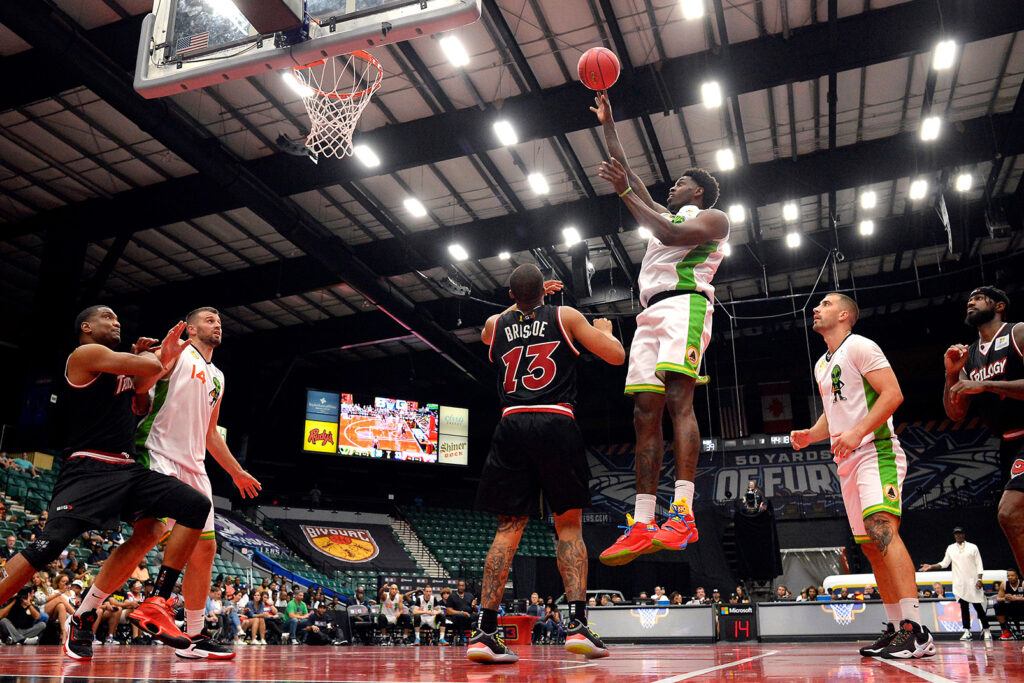Being competitive is second nature to Lisa Leslie, a Hall of Famer who’s earned four Olympic Gold Medals, two WNBA titles and three WNBA MVP awards.
This is, after all, the first woman to dunk in a WNBA game – 20 years ago with the Los Angeles Sparks.
Since 2019, she’s been head coach of the BIG3 men’s basketball league’s Triplets team, leading them to a championship that very first year (and adding a Coach of the Year award to her very crowded mantle).
But never one to rest on her laurels, none of those achievements lessened her drive to win.
In June, on the second weekend of BIG3’s fifth season, after her team had already won a game, she was back on the court to check out the team they’d be playing the next week. (BIG3’s 12 teams play on a half-court with the first team to reach 50 points winning, so they’re able to play three 45–50-minute games in a row each weekend day, broadcast live on CBS.)
She sat on a stool on the sidelines, focused on her team’s future opponent the entire game. Her team lost in the playoffs last season, motivating her to come back this year and revamp, to come back stronger.

Head Coach Lisa Leslie on court before a BIG3 game, holding a Surface tablet (Photo by Timothy Hiatt/Getty Images)
Her mantra – she takes a moment to find it in her purse because it’s what she tells her team, and she wants to be precise about it – is “Victory belongs to the most tenacious.”
“Tenacity is what I played with, that’s what I coach with, and that’s what I want to be contagious with my players. I understand the game at the highest level so we’re communicating on the same frequency,” she says of working with the men on her team, who range from two-time league MVP Joe Johnson (who spent 17 seasons with the NBA) to Jeremy Pargo (who spent three seasons in the NBA). “I’m not here to teach them how to play basketball. But I am giving them essential pieces and details that can help them be effective in each game, both offensively and defensively.”
Leslie, who says she was “always an analytics person, even as a player,” puts a lot of value on efficiency and data. And in the BIG3’s fifth season, which kicked off in June right after the NBA Finals, players and coaches were able to tap into technology that can help them score smarter and better: BIG3 Heat Vision powered by Microsoft, the league’s official technology partner.

Technician adjusting cameras and sensors above the basketball court rim before a BIG3 game (Photo by Microsoft)
That technology comes though the Noah Basketball system, which uses over-the-rim cameras, Microsoft Kinect sensors and Microsoft Azure-backed analytics to track not just every shot made and missed, but the arc of each shot and the ball position within the rim. (Noah tracks this on both makes and misses so teams can see miss patterns as well.) Players and coaches can use the instant feedback to course correct and develop strategies, such as where on the court they’re most likely to score from most consistently. They can see metrics like shot arc, shot depth and shot left-right, which are critical to shooting success. Noah’s fully automated system debuted at the Sloan Sports Conference at MIT in 2017 – a prominent sports analytics conference – and basketball teams at every level already use it, from high schools to colleges to NBA teams. Noah is now installed in 24 NBA practice gyms.
And now, the BIG3 has taken the system up a notch by adding the power of real-time analytics and storage via the Microsoft Azure cloud, where this high-definition data can live and get converted into videos and graphics. At games and practices now, there’s a Surface Hub on the sidelines to display those analytics; something that broadcasters, coaches, players and even fans can look at.
“We wanted to make sure we could help our players be the best they could be,” says Ice Cube, the prolific actor, producer and hip-hop pioneer who co-founded the league in 2017 with entertainment executive Jeff Kwatinetz. “And Microsoft provides us with the great analytics that our players need. Our coaches and players will use it to the best of their ability. Fans want to break down all the numbers, too. I want to make sure the fans have a great experience and are engaged, that’s what it’s all about. All the way around, the more information, the better.”
He’s also enthusiastic about being the first league that is using the Noah system with Microsoft on the backend – a sentiment Noah shares.
“This is a Microsoft end to end solution as far as the underpinning and the foundation,” says John Carter, Noah’s CEO and a lifelong basketball fan. “We use the Azure Kinect depth sensor to track the ball and that’s a really, really critical piece for us. What was so refreshing about Microsoft is that they were really quick to catch the vision of what we could do in-game. At the end of the day, the most important skill in basketball is shooting. Historically the team that shoots the best is the team that wins.”
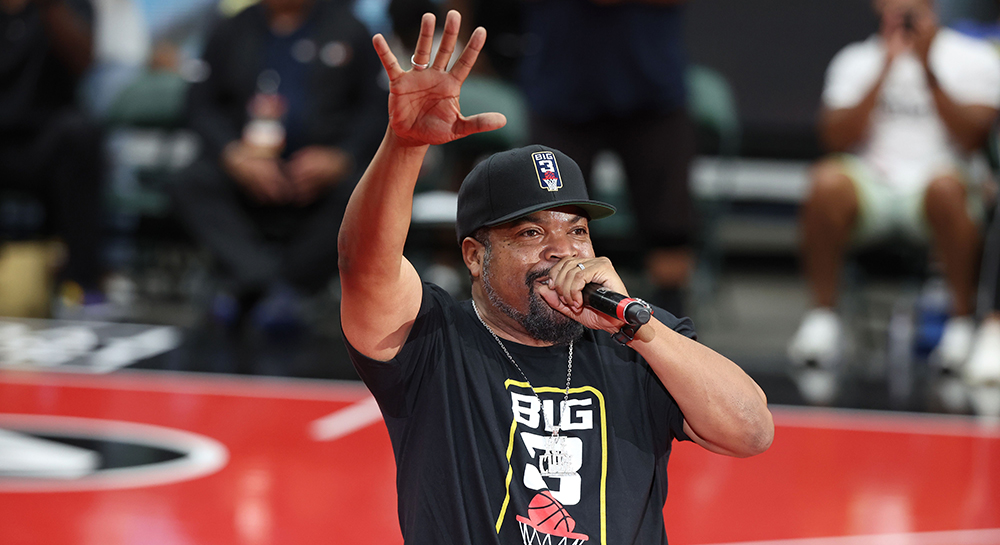
BIG3 co-founder Ice Cube performs at halftime during a BIG3 game. (Photo by Richard Rodriguez/Getty Images)
Using this system, players can change their muscle memory to shoot the optimal trajectory to deliver the ball deep in the basket – a sure bullseye. Data analytics tells the why behind the stats, factoring in variables such as fatigue, injury or a player being heavily defended to determine what’s going on when they’re shooting best from the right, or not at all from left, or if their arc is too high, or shooting too flat as the season goes on, etc.
It’s another slam dunk for the BIG3, says the league’s CEO, Christopher Hannan, who says the new technology fits in with “an innovative league that’s bringing new rules to basketball.”
Those rules are aimed at giving hoops fans a unique experience. They include a 14-second shot clock, 4-point circles, no quarters and a brief half-time, single 2-point free throws and a first-of-its-kind “Bring the Fire” rule that allows teams to challenge one foul per half resulting in an in-game one-on-one. The teams in the league – which are not tied to cities – are a mix of international players, NBA alums and younger rising stars with Hall of Fame coaches such as Leslie and Julius Erving (aka Dr. J). Games go by quickly, with three matchups on each weekend day, so all 12 teams in the league play over those two days for most of the summer, in Chicago and Dallas.
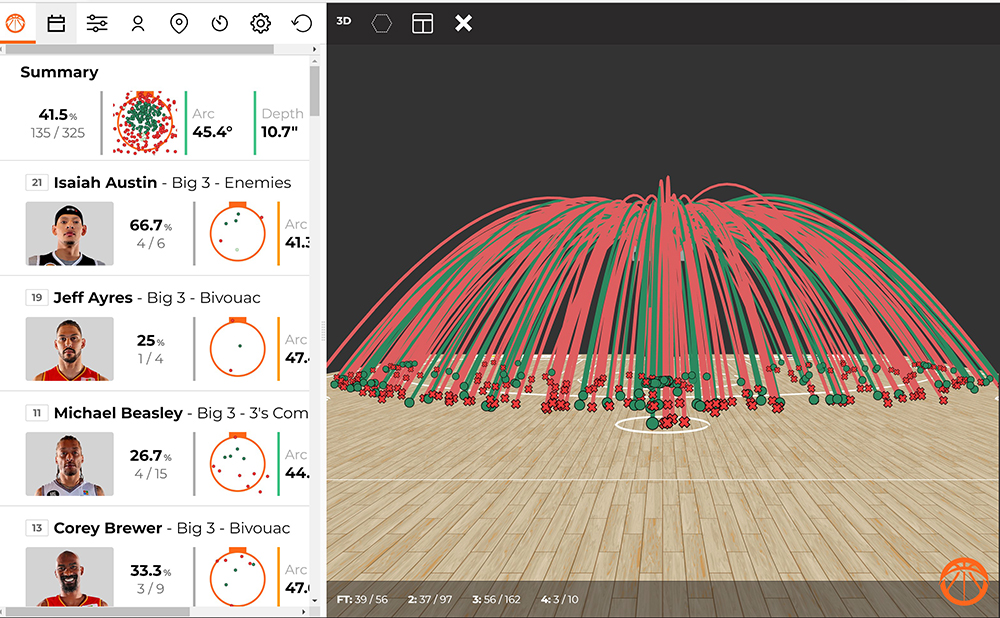
A screenshot of the shot arcs and player stats available on the Surface Hub during BIG3 games and practices
Matchups look a lot different from games fans may be used to watching, but it’s probably familiar to anyone who’s ever played at the neighborhood court, where it’s much easier to find three on three to play on a half-court.
“Technology, data and analytics are so important in sports,” says Hannan. “We’ve developed this relationship and partnership with an eye on the future. Noah is new to the equation and us working with Microsoft has come together on that. We have a name for it. It’s called Heat Vision powered by Microsoft. It’s a transformative concept to how you can track performance and use that data to increase fan interest and upgrade the broadcast because we’re now going to give fans analysis that didn’t exist before. Shot charts are very popular in sports now, but this is taking it to a whole other level, showing the actual arc, where they’re missing from and where they’re making shots from.”
Leslie first noticed the Surface Hub on the sidelines of the court at practice, the night before her team’s second game against the Aliens. She was looking at sweet spots where her players liked to go and their shooting percentages, to understand who’s the best shooter.
“I don’t have to overload them with the analytics, but they expect I’m doing my homework as a coach to put them in the best position possible,” says Leslie, who jokes that the only coaching she’d done prior to the BIG3 was for her son’s fourth grade team. “The part I can’t teach is that heart and effort. The player in me is always trying to instill that level of intensity. I need their dedication and commitment because I’m here committed to winning championships. That’s it.”
That’s the same mindset that drew another Basketball Hall of Famer, Nancy Lieberman, to the league.
Lieberman played in the Women’s Professional Basketball League and WNBA. She also came in with years of coaching experience: in the WNBA, NBA D-League (head coach of the Texas Legends, affiliate of the Dallas Mavericks) and NBA (Sacramento Kings assistant coach).
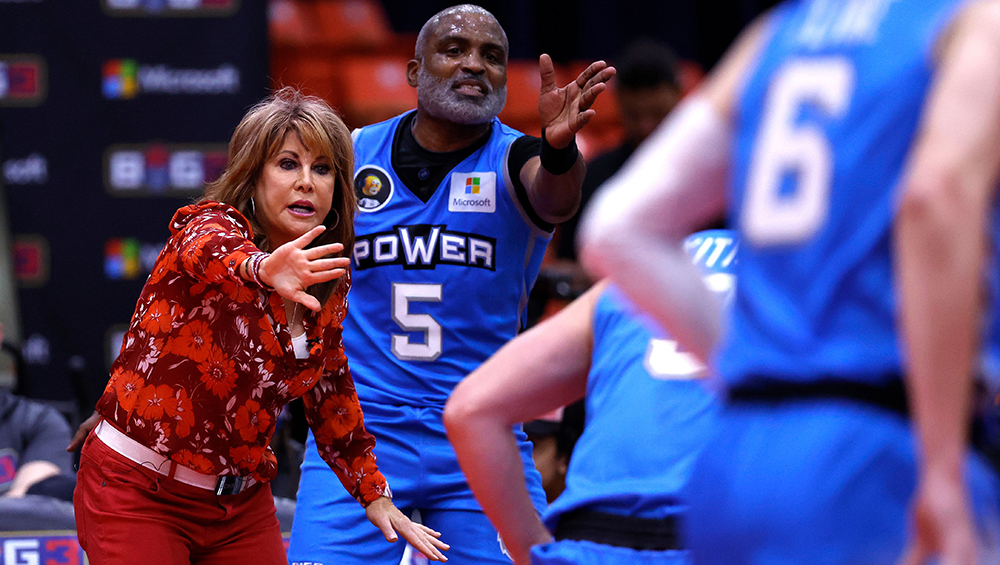
Nancy Lieberman coaching her team, Power, during a BIG3 game (Photo by Kirk Irwin/Getty Images)
She was coaching with the Kings when she found out her mother, who lived in Florida, was sick. “A no regrets kind of girl,” Lieberman made the decision to step down to spend more time with her.
While she was with her mother, she was following the 2018 NCAA tournament, but also flipping channels in between games. While watching “Straight Outta Compton” – a film which dramatizes Ice Cube’s early days with NWA – she got a call from him asking if she’d be interested in coaching for the BIG3, a coincidence not lost on her. And like most basketball players, she’d grown up playing three-on-three, at some of the most competitive courts in New York City. But her decision wasn’t a sure thing, at first. She wanted to make sure Ice Cube wasn’t just checking a box (to have a woman coach). He was adamant it wasn’t about that.
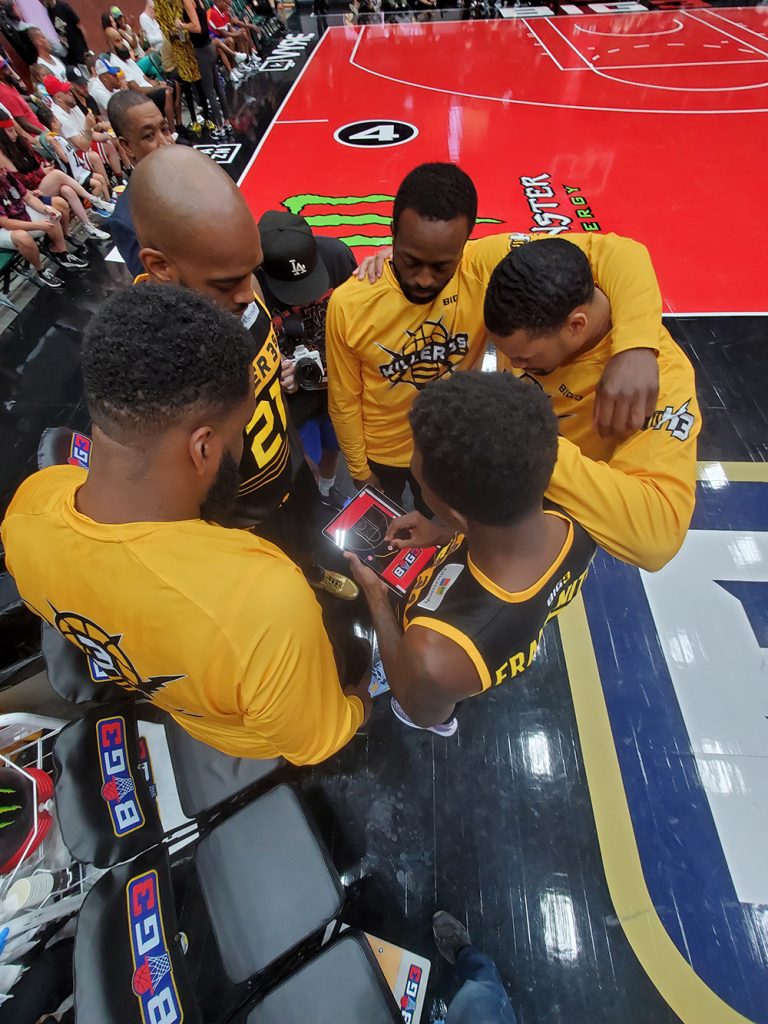
BIG3 Killer 3s players huddled around a tablet during a BIG3 game (Photo by Microsoft)
And to further make his point he considered her on the same level as the other coaches (such as Dr. J, Rick Barry, Rick Mahorn and George Gervin) – all Hall of Famers she’s known for decades.
“You know, he’s a culture changer and he wants diversity and inclusion, and he did it. And when we won the championship, I was thrilled. It couldn’t have happened to a better team, but also to a better man than Ice Cube because he gave me an opportunity and we got to prove him right,” says Lieberman.
She sees a lot of value in using technology to achieve those victories and was the first one in the BIG3 to check out the new analytics platform during BIG3’s most recent Combine event. She uses a Surface tablet to draw plays during games.
“I’m looking for anything that can help me get results,” says Lieberman, who describes herself as a visual person, so seeing what the Noah system produces really engages her. “You’re always looking for consistency, and you really want that with your mechanics. This platform has taken it to another level with how you can view it from up above, or from a court level. You can see the arc of the shot. You can see how deep the shot is, where it’s going into the basket. It’s just giving us so much more information.”
She brought players over to the Surface Hub that showed them all the different ways their shots were being measured, and how the data it shows reinforces what coaches like her are saying.
“I’m definitely a fan of analytics. I want to know how we can get better. You don’t want it to rule you. But you certainly want to respect it because it gives insight in what other teams and other players are doing,” Lieberman says. “It can change how you see the game.”
Top photo: BIG3 Aliens player Deshawn Stephens shoots in a game against the Trilogy team (Photo by Logan Riely/Getty Images)

